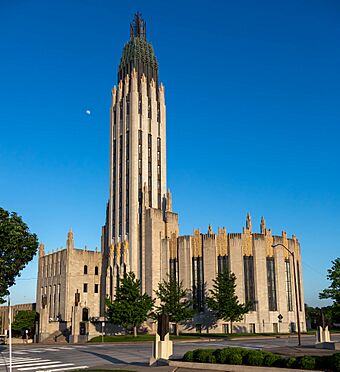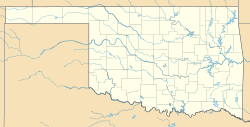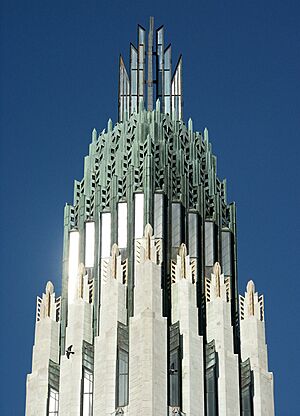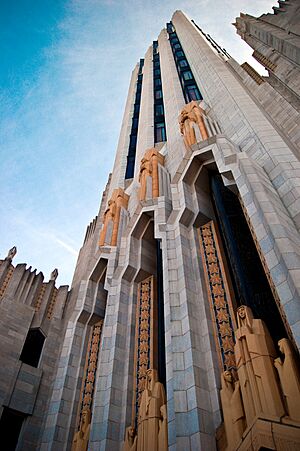Boston Avenue Methodist Church facts for kids
|
Boston Avenue Methodist Episcopal Church, South
|
|

The church in May 2022
|
|
| Location | 1301 South Boston Ave., Tulsa, Oklahoma |
|---|---|
| Built | 1927–1929 |
| Architect | Bruce Goff from a design by Adah Robinson |
| Architectural style | Art Deco |
| NRHP reference No. | 78002270 |
Quick facts for kids Significant dates |
|
| Added to NRHP | August 31, 1978 |
| Designated NHL | January 20, 1999 |
The Boston Avenue United Methodist Church in Tulsa, Oklahoma, is a famous building completed in 1929. It's known as one of the best examples of Art Deco style churches in the United States. This church is so special that it's listed on the National Register of Historic Places and was named a National Historic Landmark in 1999. It stands tall with 15 floors.
Contents
Building a Unique Church
The design of the Boston Avenue Church cost about $1.25 million. Two people are given credit for its unique look: Adah Robinson and Bruce Goff. Adah Robinson was an art teacher in Tulsa. She first drew the ideas for the church. Bruce Goff was one of her former high school students. He was also the architect for her home and studio. Bruce Goff took Adah's sketches and created the final design for the church.
The official architecture firm was Rush, Endacott and Rush. Bruce Goff worked there since he was 12 years old. He became a partner in 1930. There is still some discussion about who was more responsible for the building's design. The church gives credit to Adah Robinson. However, experts on Bruce Goff believe it is clearly his design.
Art Deco Style and Features
The original church building had a round main room for services. It also had a tall tower that reached 225 feet (68.5 meters) into the sky. Another part of the building held classrooms. The tower's straight, soaring lines connect it to old Gothic cathedrals. It also shows off the vertical style of Art Deco design.
At the top of the tower, and on other high points, are sculptures. These sculptures look like two hands raised in prayer. This "praying hands" idea is seen all over the building. It's one of the design elements that came from Adah Robinson's early drawings.
The Boston Avenue Church uses many different building materials. These include metal, glass, terra cotta, Indiana limestone, and Minnesota granite. The outside of the church has many terra cotta sculptures. These were made by a sculptor named Robert Garrison. He had been a student of Adah Robinson's. The sculptures show groups of people praying. They represent spiritual life, religious education, and worship. The "two hands together" design is also found in these groups.
Above the south entrance, there are statues of "Circuit Riders." These statues show early Methodists who traveled on horseback to spread their faith. Two of the riders are real people: Bishop Francis Asbury and Bishop William McKendree. The third rider in the middle stands for all other men of God who rode horses to do their work. The face of this rider was modeled after the church minister's father-in-law, Rev. T.L. Darnell. Rev. Darnell had been a circuit rider for 50 years.
Above the north entrance, there are statues of John Wesley, his brother Charles Wesley, and their mother, Susanna Wesley. Other parts of the church's outside design show classic Art Deco plant patterns. These designs, like the stained glass windows, were inspired by Oklahoma flowers. The tritomas and coreopsis flowers are especially noticeable.
Church Recognition and Additions
The Boston Avenue Church quickly impressed people in the world of architecture. A famous art critic named Sheldon Chaney praised the church. He said its details were "daringly new" and its designs were "fresh and vital."
In 1978, the building was added to the National Register of Historic Places. It was then named a National Historic Landmark in 1999.
In 1993, new murals were added to the church. This was for the 100th anniversary of the church's founding. A Chicago artist named Angelo Gherardi designed them. He made sure the murals matched the Art Deco style of the rest of the building.
A columbarium was finished inside the church in 2000. A columbarium is a place where the ashes of people who have been cremated can be kept. This one was designed by Tulsa architect Roger Coffey. It allows church members and their families to have their ashes placed there. The columbarium has a 6-foot (1.8-meter) by 25-foot (7.6-meter) cut glass window. This window was made by Richard Bohm of the Tulsa Stained Glass company.
A stone from the Boston Avenue United Methodist Church is part of the Chicago Tribune Building. This famous building in Chicago has over 100 stones from historic buildings and famous places around the world.
The Boston Avenue Church also has a large Möller pipe organ. It was first dedicated in 1962. The organ has been made bigger and improved several times since then.
The W. S. Bellows Construction Corporation built the church.
See also






